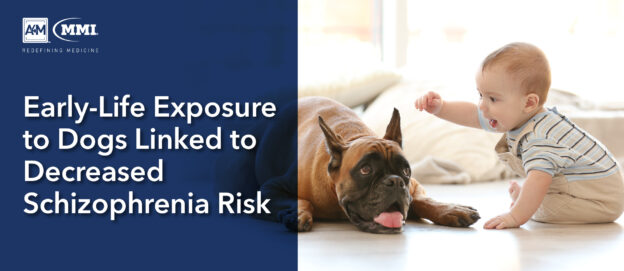Owning a pet has been associated with many health benefits, ranging from decreased blood pressure and cholesterol levels to increased life expectancy. Pet dogs specifically provide opportunities for increased physical activity, socialization, and time spent outdoors while also improving emotional well-being by providing their owners with companionship. As a result, pet ownership is on the rise, according to data from the American Pet Products Association’s National Pet Owners Survey. Per current estimates, 67% of households in the United States own at least one pet – which equals approximately 85 million homes across the country.
The full extent of the health benefits – and risks – of pet ownership is yet unknown, however, the latest research reveals that there may be positive neurologic implications of owning a dog. Published online in the journal PLOS One, a recent study from Johns Hopkins Medicine implicates that exposure to dogs at an early age may have psychiatric health benefits, including the lessening of the likelihood of schizophrenia development in adulthood.
Early-Life Exposure to Household Pets and the Risk of Psychiatric Disorders
Bipolar disorder, schizophrenia, and other serious psychiatric disorders have been linked to early-life environmental exposures – which could also include contact with household pets. A team of researchers from John Hopkins Medicine investigated the relationship between exposure to household pets – cats or dogs – during the first 12 years of life and the subsequent diagnosis of either schizophrenia or bipolar disorder.
Led by chair of the Stanley Division of Pediatric Neurovirology and professor of neurovirology in pediatrics at the Johns Hopkins Children’s Center, Robert Yolken, MD, the team evaluated a cohort of 396 individuals with schizophrenia, 381 with bipolar disorder, and 594 control subjects. Participants were between the ages of 18 and 65 and had a household pet cat, dog, or both during the first 12 years of life. Control group members had no current or prior history of psychiatric disorders.
Researchers calculated hazard ratios using Cox Proportional and multivariate logistic regression models – which included socio-demographic covariates. Their analysis was conducted for four distinct age ranges: birth to age 3, 4 to 5, 6 to 8, and 9 to 12.
Dog Ownership and Schizophrenia
Dr. Yolken and his colleagues’ findings reveal that exposure to a household pet dog in childhood was associated with a significantly reduced likelihood of subsequent schizophrenia diagnosis (HR 0.75, p <.002). As much as a 24% decreased relative risk of schizophrenia was observed following exposure at birth and during the first years of life – or before the age of 3. However, there was no significant relationship between exposure to either household cats or dogs and the subsequent development of bipolar disorder. There was also no association between cat ownership in early life and schizophrenia diagnosis.
Although, Dr. Yolken notes that there was a slightly increased risk for both disorders in participants who were in contact with cats between the ages of 9 and 12. “This indicates that the time of exposure may be critical to whether or not it alters the risk,” he told ScienceDaily.
Early-Life Exposures and Environmental Risk Factors
Neuropsychiatric disorders contribute to extensive morbidity and mortality across the globe. While current knowledge identifies genetic and environmental factors as risks for the development of schizophrenia and bipolar disorder, little research has been conducted to evaluate the significance of early life exposures within the household, which may contribute to the known familial associations of disease risk.
“Serious psychiatric disorders have been associated with alterations in the immune system linked to environmental exposures in early life, and since household pets are often among the first things with which children have close contact, it was logical for us to explore the possibilities of a connection between the two,” Dr. Yolken explains. Prior research has identified cats and dogs as immunomodulatory factors, which can result in allergic responses, contact with animal bacteria and viruses, changes in household microbiome, and pet-induced stress reduction. This immune modulation is suspected to alter the risk of psychiatric disorder development in cases of genetic predisposition; however, the extent of the underlying mechanisms remains unknown.
The “protective effect” of dog exposure observed in the latest study may be due to compounds in the canine microbiome that either alter the immune system or mitigate genetic predisposition to schizophrenia, Yolken notes. If the hazard ratio found in the latest study accurately reflects relative risk, approximately 840,000 cases of schizophrenia – or 24% of 3.5 million Americans diagnosed with the disorder – could be prevented with early-life dog exposure.
Previous studies have investigated the link between cat exposure and psychiatric disorder development; however, this study is among the first to include household pet dogs in its analysis. As the trial’s findings reveal, the development of schizophrenia and other serious psychiatric disorders may be influenced by exposure to household pet dogs in childhood. Additional research is needed to confirm the recent findings, as well as to identify the factors contributing to the connection and define the risks of developing psychiatric disorders from household pet exposure during child, or lack thereof. Understanding the underlying mechanisms of the relationship between pet exposure and psychiatric disorders would allow for the development of improved prevention protocols and treatment strategies, bringing tremendous potential for enhanced patient care.

